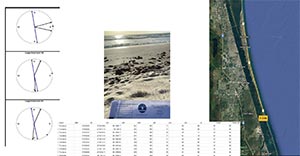Grant: 20-031R
Project Title: Characterizing the light environment and hatchling orientation index on Brevard South Beaches
Project Manager: Ashley Chelberg
Organization: Stella Maris Environmental Research (Non-Profit Organization)
Grant Amount: $8,533.00
Completion Date: 2021-10-18
Summary: A study on the light environment and hatchling orientation index (HOI) of the South Brevard beaches will quantify the effects of artificial lighting on hatchling sea-finding and potentially foreshadow the future conservation status of Florida marine turtles. As human population or recreation increases in this area, the need to define the efficacy of current lighting ordinances will be addressed by characterizing the lighting environment on South Brevard beaches, as well as identifying compliance to the ordinances, and potential solutions for beaches with disruptive lighting. Determining hatchling orientation, illuminating the light environment on the beaches and educating the public can lead to the reduction of artificial lighting impacts to hatchlings in the South Beaches of Brevard County. Further, results of this study may be used to inform conservation managers whether current lighting ordinances are sufficiently protecting sea turtles. Data collected will be sent to FWC/FWRI for integration into their current studies on beach lighting affecting hatchling orientation and compared to historical studies. Results: Understanding effects from beach lighting on emerging hatchlings is an important ongoing challenge being addressed with our study. Our work with artificial lighting and hatchling orientation takes place on an important nesting beach known worldwide. The potential rate of disorientation and observed disorientation occurring on Indialantic and Floridana in our 2020 study outlines the need for greater investigation and for sample size expansion in 2021 allowing for statistically applicable temporal analysis using data from the 1990ís. Our data suggests these particular beaches are experiencing a range of lighting interference with normal visual cues of the moon or starlit, night sky, offering greater opportunities for hatchling mortality from low accuracy and precision to the sea. Disruption of sea finding is categorized as 'moderately' or 'severely' disrupted using measurements of modal divergence of hatchling tracks from the ocean direction or the angular range (Witherington, 2003). Floridana Beach, a mainly residential area, has expansive sea turtle nesting where data suggests this beach is severely vulnerable to light pollution for sea finding hatchlings when compared to Indialantic or Hightower beaches. Small adjustments in beachfront lighting can have exponential effects, thus requiring scrupulous hatchling orientation measurement. Modal divergence and angular range values are lower on beaches in Floridana, suggesting greater integrity of the nesting habitat in respect to light pollution. Indialantic has more commercial properties beachfront and according to our data, greater exposure to artificial lighting. Higher values of angular range and modal divergence in this region alludes to instances of sea finding disruption for hatchlings. Larger sample sizes will support greater insights into statistical analyses and contribute to future populations of marine sea turtles.
Results: Understanding effects from beach lighting on emerging hatchlings is an important ongoing challenge being addressed with our study. Our work with artificial lighting and hatchling orientation takes place on an important nesting beach known worldwide. The potential rate of disorientation and observed disorientation occurring on Indialantic and Floridana in our 2020 study outlines the need for greater investigation and for sample size expansion in 2021 allowing for statistically applicable temporal analysis using data from the 1990ís. Our data suggests these particular beaches are experiencing a range of lighting interference with normal visual cues of the moon or starlit, night sky, offering greater opportunities for hatchling mortality from low accuracy and precision to the sea. Disruption of sea finding is categorized as 'moderately' or 'severely' disrupted using measurements of modal divergence of hatchling tracks from the ocean direction or the angular range (Witherington, 2003). Floridana Beach, a mainly residential area, has expansive sea turtle nesting where data suggests this beach is severely vulnerable to light pollution for sea finding hatchlings when compared to Indialantic or Hightower beaches. Small adjustments in beachfront lighting can have exponential effects, thus requiring scrupulous hatchling orientation measurement. Modal divergence and angular range values are lower on beaches in Floridana, suggesting greater integrity of the nesting habitat in respect to light pollution. Indialantic has more commercial properties beachfront and according to our data, greater exposure to artificial lighting. Higher values of angular range and modal divergence in this region alludes to instances of sea finding disruption for hatchlings. Larger sample sizes will support greater insights into statistical analyses and contribute to future populations of marine sea turtles.